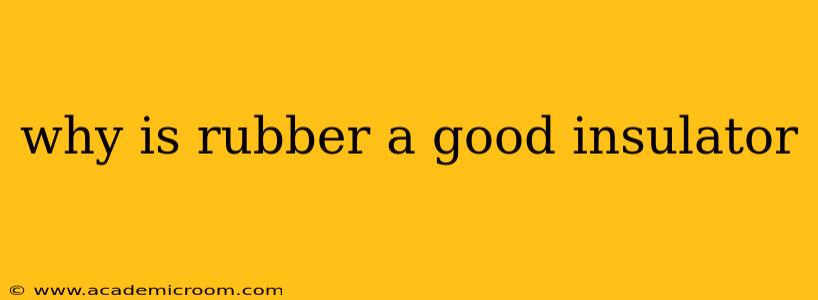Rubber's excellent insulating properties make it a crucial material in various applications, from electrical wiring to protective gloves. But what exactly makes rubber such a good insulator? This comprehensive guide delves into the science behind rubber's insulating capabilities, exploring its molecular structure and explaining why it's preferred over other materials in specific contexts.
What Makes Rubber a Good Electrical Insulator?
Rubber's effectiveness as an insulator stems primarily from its molecular structure and the resulting lack of free electrons. Unlike conductors like metals, which possess a "sea" of freely moving electrons, rubber's electrons are tightly bound within its long-chain polymer molecules. This strong electron binding prevents the easy flow of electric current, making it a highly resistive material.
The specific type of rubber also plays a role. Natural rubber, derived from the sap of rubber trees, and various synthetic rubbers exhibit different levels of insulating properties. These differences are due to variations in their chemical composition and the presence of additives that can influence conductivity.
How Does Rubber's Insulating Capacity Compare to Other Materials?
Rubber's insulating capacity is significantly higher than that of many other materials commonly used in electrical applications. For instance, it boasts superior insulation compared to materials like wood or certain plastics. This difference makes rubber the preferred choice in high-voltage applications where a high degree of insulation is paramount to prevent electrical shocks and short circuits. The specific comparison depends on the type of rubber and the material it's being compared to; detailed specifications are available in engineering handbooks and material science databases.
What are the Different Types of Rubber Used as Insulators?
Several types of rubber are employed as electrical insulators, each possessing unique properties suited for specific applications:
- Natural Rubber (NR): Possesses good insulating properties but is susceptible to degradation from ozone and UV radiation.
- Styrene-Butadiene Rubber (SBR): A synthetic rubber offering cost-effectiveness and decent insulating capabilities, often used in less demanding applications.
- Neoprene (Polychloroprene): Exhibits excellent resistance to oils, chemicals, and weathering, making it ideal for harsh environments.
- Silicone Rubber: Features high heat resistance, making it suitable for high-temperature applications.
- Ethylene Propylene Diene Monomer (EPDM): Known for its excellent weather resistance and ozone resistance, often used in outdoor applications.
The choice of rubber type depends on the specific requirements of the application, considering factors like temperature range, chemical exposure, and mechanical stress.
Is Rubber a Good Thermal Insulator?
While primarily known for its electrical insulation, rubber also possesses some degree of thermal insulation. Its ability to impede the transfer of heat is not as pronounced as its electrical insulation, but it still provides a level of protection against heat transfer. This property is exploited in applications such as protective gloves and certain types of thermal insulation layers.
What are the Limitations of Rubber as an Insulator?
Despite its advantages, rubber does have limitations:
- Vulnerability to Degradation: Certain types of rubber can degrade over time due to exposure to sunlight, ozone, oils, and chemicals.
- Temperature Sensitivity: The insulating properties of rubber can be affected by extreme temperatures, either high or low.
- Mechanical Stress: Excessive mechanical stress can damage the rubber, compromising its insulating capabilities.
Can Rubber Lose its Insulating Properties?
Yes, rubber can lose its insulating properties over time due to factors like age, exposure to environmental elements (UV radiation, ozone), chemical degradation, or physical damage. Regular inspection and timely replacement are crucial in applications where maintaining insulation integrity is critical.
This article offers a comprehensive overview of why rubber is a good insulator. Remember that the specific type of rubber significantly impacts its performance, and understanding these nuances is crucial for selecting the appropriate material for various applications. Further research into specific rubber types and their properties is recommended for precise engineering applications.
